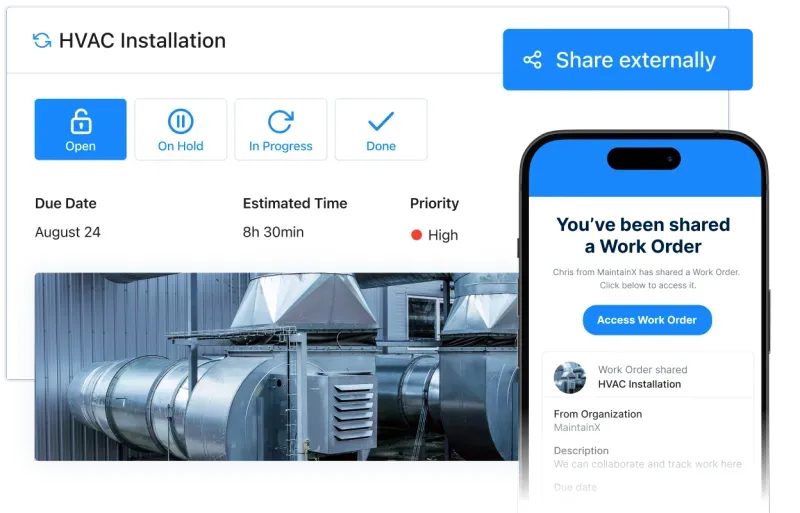
Facility maintenance is what keeps the lights on, literally and figuratively. It's a concept that anyone who maintains a commercial building should have a solid grasp of. Yet, it’s often overlooked or misunderstood, which can lead to avoidable issues down the line.
In this guide, we'll break down everything you need to know about facility maintenance: the different types, who’s in charge of what, and how modern digital tools can level up your performance.
Key takeaways
- Proper facility maintenance is about keeping buildings, equipment, and day-to-day operations running smoothly.
- Most programs include four core approaches: corrective, reactive, preventive, and predictive maintenance.
- When done right, facility maintenance helps keep a building’s occupants safe while avoiding unplanned downtime.
- Certifications and ongoing training are key to helping facility maintenance workers adapt to new tech and compliance demands.
What is facility maintenance?
Facility maintenance refers to all the work that goes into keeping a facility’s physical assets, like HVAC systems, lighting, plumbing, machinery, and structures, in safe, working order. This includes everything from routine maintenance and repairs to emergency response, compliance checks, and strategic upgrades. The goal is simple: Keep buildings working the way they should.
Why facility maintenance matters
Facility maintenance should be invisible to a building’s occupants. When everything is working well, nobody thinks twice about the temperature or the lights turning on when they should.
This is the ultimate goal for your facilities teams. It’s also harder than it looks. Even a small issue, like a leaky pipe, can trigger a chain reaction that disrupts operations and compromises safety. No system is perfect, and some surprises are inevitable. But preventing issues in the first place is far easier than cleaning up the messes they cause.
Ultimately, your facility maintenance program is aiming to keep all disruptions to a minimum. When that’s the case, everyone wins. The professionals using the space can focus on their work while your team has the breathing room to focus on higher-impact projects.
What are the key responsibilities of facility managers?
Facility managers have a seemingly routine job: Keep buildings safe, comfortable, and functional. However, as you know, a lot goes into making this a reality. Broadly speaking, your work falls into two main buckets: strategic and operational.
On the strategic side of things, there are long-term considerations like asset planning. For instance, how will a new HVAC system affect energy costs? You also need to stay up to date with evolving rules and regulations from government agencies like OSHA.
At the same time, you have to balance this long-term thinking with day-to-day upkeep. Your operational responsibilities include everything from managing vendor relationships to ensuring work orders are completed promptly.
The four types of facility maintenance
When it comes to facility maintenance, it often makes sense to categorize your work into four main types. These include corrective, reactive, preventive, and predictive maintenance. Here’s a closer look at what these all entail.

Corrective maintenance
When something isn’t working right but hasn’t failed entirely, corrective property maintenance is the best course of action. Think of it like a yellow stoplight. A faulty valve or a flickering bulb might still be functional, but ignoring it could lead to bigger problems down the line. Prioritizing repairs at this stage reduces costs in the long run by extending asset lifespans and limiting operational disruptions.
Reactive maintenance
Reactive maintenance is your worst-case scenario. Something has completely failed and needs to be addressed ASAP.
Also known as breakdown maintenance, this kind of maintenance often causes operational standstills or delays. For this reason, your team should do everything in their power to not only get things up and running again but also to avoid this kind of maintenance in the future.
Preventive maintenance
Preventive maintenance is the work your team does to avoid unplanned, reactive maintenance. This kind of maintenance includes scheduled inspections, lubrication, cleaning, and other routine activities that keep key components running at their best.
Predictive maintenance
The most advanced teams take things a step further via predictive maintenance. These strategies build on preventive maintenance by using real-time monitoring tools to detect issues before they cause downtime.
For instance, your team could use AI models to analyze data from IoT sensors and historical maintenance records to spot patterns, like temperature spikes or vibration anomalies, that previously led to equipment failures. When those patterns show up again, the system flags them right away, giving your team time to act before anything breaks.
Common examples of facility maintenance management
Facility maintenance covers a wide range of responsibilities, some routine, others more strategic. Here are some of the most common areas your team likely manages every day.
1. Environment, health, and safety (EHS)
Keeping people safe should be priority number one for your facility maintenance plan. But there’s a lot to keep track of here, from making sure safety equipment is in good working order to managing exposure to hazardous materials. One way you can promote a strong EHS posture is to always stay well-stocked with personal protective equipment and to make sure operating procedures for this equipment are clear and visible.
2. Fire safety
Facility managers are responsible for maintaining all fire safety systems: extinguishers, alarms, sprinkler systems, and emergency signage. Make sure your facility maintenance plan includes a checklist that outlines when and how these systems need to be inspected.
3. Security
Keeping a facility secure requires a lot more than just locks and cameras. Modern buildings rely on comprehensive surveillance systems to control who comes and goes. In many cases, you should also coordinate with third-party contractors to provide on-site security personnel and manage other security-related services.
4. Cleaning and sanitation
Keeping a facility clean is non-negotiable, but what that requires can vary from building to building. Just about every facility needs regular restroom and common-area sanitization, but beyond that, it varies by building type. Hospitals, for example, have more stringent cleaning requirements than most offices.
5. Operational tasks
On top of managing larger systems, facility managers are the go-to problem-solvers for day-to-day building needs. You might need to adjust thermostat settings one minute and respond to a noise complaint the next. No two days are the exact same.
6. Business continuity planning
When something big goes wrong, like a flood, fire, or extended power outage, facility managers are often the ones leading the response. This means your team will be expected to help make sure teams stay safe and operations get back up and running as fast as possible. That could mean anything from coordinating emergency repairs to relocating the business temporarily. A good continuity plan ensures everyone knows what to do when the unexpected hits.
7. Space allocation and planning
Your company’s facility needs are rarely static. If you’re expanding, restructuring, or even moving to a remote-first model, the layout and use of a facility often need to change.
It’ll be your job to oversee space planning to accommodate these changes, such as by reconfiguring offices and common areas. You also need to make sure the new space adheres to statutory requirements: proper ventilation, ADA compliance, emergency signage, and even lighting standards.
What buildings typically need facility maintenance?
The work your team does is going to be very different depending on the kind of building you’re maintaining. Different types of buildings come with different requirements, expectations, and challenges. Here are a few common examples.
Offices and commercial buildings
Office buildings, warehouses, and other commercial spaces tend to be the most straightforward facilities to maintain. They usually only require the basics: temperature, lighting, elevators, and the like.
Hospitals
Hospitals and healthcare facilities have much higher standards than most commercial buildings. Facility managers need to oversee more involved sanitation procedures, along with expensive equipment like MRI machines.
Universities
Universities are like small cities, often consisting of dozens of buildings with varying components. This presents a unique challenge for your facility management team. Classrooms, dormitories, laboratories, and libraries all have different maintenance requirements. Facility management software solutions that help managers keep track of all these different needs are particularly valuable in these settings.
Strategies to improve facility maintenance
As a facility manager, you’re likely always looking for ways to improve your spaces. Here are a few strategies that can make the work you and your team perform every day easier and more effective.
Use a CMMS to centralize work orders and reporting
When work orders live in different systems, it’s inevitable that something will get missed eventually. A Computerized Maintenance Management System (CMMS) makes it far easier to keep track of all of a facility’s moving parts by bringing everything together in one central location. Teams can submit, assign, and track work orders without digging through emails or chasing down updates.
It's great for managers, too, who get a snapshot of where facility performance is at any given time.
Install IoT technology
With IoT tools, machines can communicate when they need to be serviced. For example, a vibration sensor on a motor might pick up an unusual reading that points to an impending failure.
The use of these kinds of sensors is known as “condition-based maintenance,” and it’s becoming increasingly widespread in all kinds of facilities. This approach is one of the best ways for your team to move from a reactive to a predictive maintenance framework, especially in buildings with aging infrastructure.
Optimize preventive maintenance schedules
The benefits of preventative maintenance are undeniable: fewer disruptive breakdowns and longer asset lives. But actually doing it well is trickier than it seems. If you’re not careful, you either over-maintain and waste resources or under-maintain and deal with downtime.
The key is consistency without overkill. Routine tasks like filter swaps or safety checks should be built into your facility’s workflow with the help of management software. Tools like MaintainX can trigger alerts exactly when tasks need doing, based on time, usage, or condition, so nothing gets passed over or done too early.
Finding that balance helps teams keep equipment running smoothly while avoiding unnecessary spending on emergency repairs or overtime labor.
Monitor KPIs and maintenance costs regularly
Keeping track of a few meaningful maintenance KPIs will tell you exactly where your maintenance strategy is actually moving the needle, and where it isn't. Equipment downtime, work order completion rates, maintenance spend, and occupant complaints are all good variables to keep an eye on.
Facility maintenance certifications and training
You don’t need an engineering degree to oversee a well-functioning building maintenance program, but formal training can go a long way. New technologies and regulations are making buildings more complex, and facility managers are expected to at least have a surface-level understanding of just about everything. The right certifications can make a real difference here.
Two of the most well-known credentials in the space come from the International Facility Management Association (IFMA): the Facility Management Professional (FMP) and Certified Facility Manager (CFM). Both programs are recognized around the world and accredited by the American National Standards Institute (ANSI).
The FMP is a great option for those new to the field or looking to bolster their understanding of a particular topic, like asset management or sustainability. If you have years of experience under your belt, the CFM is a better fit. It's geared toward professionals who want to develop mastery across a broader range of subjects like budgeting, leadership, and regulatory compliance.
Building a smarter, safer maintenance operation
The best facility maintenance programs are well-oiled machines. Teams know precisely what they need to do and when, to keep everything in good working order. And when an unexpected disruption inevitably pops up, they know exactly how to respond.
Underpinning these programs are the right processes and the right tools. But with so many software solutions on the market, how do you know which one to choose? Check out our guide to facility maintenance work order software to help you make the right decision for your team.
Frequently Asked Questions
What is the facility manager's primary responsibility when it comes to operations and maintenance?
Facility managers are responsible for ensuring that buildings, equipment, and systems are safe, functional, and efficient. That includes overseeing building maintenance schedules, managing teams, coordinating with vendors, and staying compliant with regulations.
What is the main goal of facility maintenance?
The primary goal is to extend asset life, reduce operational costs, and create a safe, reliable environment that supports the core mission of the organization.
What is a facility maintenance technician?
A facility maintenance technician is a hands-on specialist who performs inspections, repairs, and routine upkeep across electrical, plumbing, HVAC, and building systems. They’re often the first line of defense against unexpected failures.

The MaintainX team is made up of maintenance and manufacturing experts. They’re here to share industry knowledge, explain product features, and help workers get more done with MaintainX!




.jpeg)















